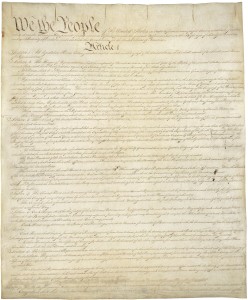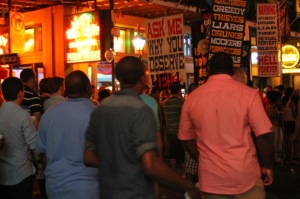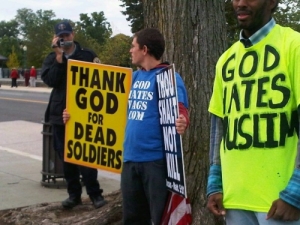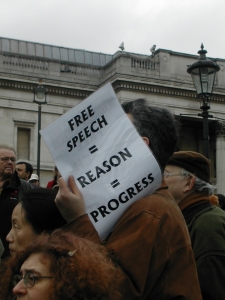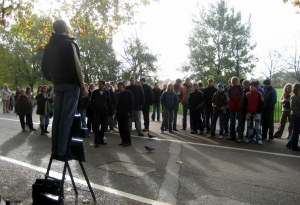By: Matthew Alan Cherep*
Introduction
Nearly one in four American adults under the age of fifty has a tattoo.[1] Modern tattoos may commemorate important events in our lives, like the birth of a child or the death of a loved one; they may signify passionately held beliefs, through a peace sign or a Gadsden Flag; they may pay tribute to one’s heritage; or they may simply be a reminder of youthful indiscretions.[2] The culture of tattoos has shifted greatly over the last fifty years; once seen as symbols of a countercultural movement, tattoos have pushed their way into the mainstream. At one point, tattooing was one of the fastest-growing retail businesses in the United States.[3] Tattoo parlors, once viewed as hangouts for bikers, dropouts, and convicts, have to an extent transformed into high-end tattoo studios frequented by everyone from Hollywood’s rich and famous to middle-aged soccer moms.[4] America’s recent embrace of tattooing has even spurred the creation of television shows, like L.A Ink, which draw millions of viewers into the world of custom tattooing.[5] In 2009, one of the most mainstream symbols of Americana, Barbie, got into the act when Mattel introduced Totally Stylin’ Tattoos Barbie, who came complete with forty unique tattoos for both Barbie and the doll owner.[6]
With the spread of tattoos came the spread of tattoo regulation. Government regulation of tattooing began to take root in the 1930s and 1940s.[7] Possibly the most important precipitating event in tattoo regulation, however, was a hepatitis outbreak in New York City in the early 1960s that was attributed to an unsanitary tattoo parlor on Coney Island.[8] The regulation of tattooing has taken many different forms, including special licensing procedures,[9] zoning restrictions that effectively create a total ban,[10] and restrictions requiring that tattooing only be administered by medical professionals.[11]
The process of tattooing, by its nature, exposes the tattoo artist and the tattoo recipient to some significant health risks.[12] To create a tattoo, an artist uses an electric machine to rapidly move a needle that punctures the tattoo recipient’s skin.[13] The needle deposits ink inside the second layer of skin, thus creating the design or image.[14] The end result of the process is “essentially an open wound.”[15] When applied in unsanitary conditions, tattooing can result in the spread of hepatitis, Human Immunodeficiency Virus (“HIV”), and other blood-borne diseases.[16] Given the gravity of these health concerns, the government has an important interest in regulating the process of tattooing.
The question remains, however, what rights, if any, do tattoo artists have in practicing their craft? Determining what rights tattoo artists enjoy depends largely on whether tattooing is considered a protected activity under the First Amendment. If tattooing is shielded by the First Amendment, then government regulation of tattooing must be narrowly tailored to achieve an important government interest.[17] Proceeding under this framework of analysis, tattoo artists will be able to ply their trade more freely. If, however, tattooing falls outside the scope of the First Amendment, government bodies may freely regulate tattooing so long as there is a rational basis for the regulation.[18] This Comment interprets tattooing and tattoo regulations under a First Amendment framework.
Part I of this Comment describes the current First Amendment framework. It provides a brief background on the history of free speech protections under the First Amendment by discussing the difference between pure and symbolic speech, as well as between content-based and content-neutral government regulation of speech. Part II traces the different paths courts have taken when balancing government regulation of tattooing against the First Amendment claims of tattoo artists. This Part highlights the varying approaches taken in Yurkew v. Sinclair[19] and Anderson v. City of Hermosa Beach.[20] In Part III, I contend that tattooing is protected symbolic speech under the First Amendment, and that government regulations of tattooing should be subjected to intermediate scrutiny. The resulting recommendation leaves tattoo artists free to create their expressive body art, while still allowing the government to enact regulations that protect the public from serious health risks.
I. Background: The First Amendment
The First Amendment of the U.S. Constitution protects citizens from efforts by the federal government to regulate expression.[21] Through the Fourteenth Amendment, the First Amendment imposes the same limitations on regulation by the states.[22] Central to the First Amendment is the belief that in our free society each person has the right to decide—free from government interference—what views she will voice.[23] “Freedom of expression would not truly exist” if it could only be exercised subject to the whim of a “benevolent government.”[24] However, not all speech is entitled to protection. Some speech is considered to have “such slight social value . . . that any benefit that may be derived from [it] is clearly outweighed by the social interest in order and morality,” and thus some speech is left outside the protection of the First Amendment.[25] Examples of unprotected speech include fighting words,[26] obscenity,[27] and libel.[28]
The First Amendment protects both “pure speech”[29] and “symbolic speech.”[30] Pure speech connotes verbal communication, either oral or written, unaccompanied by other conduct.[31] Symbolic speech is conduct that is sufficiently communicative to be treated as protected speech.[32] The First Amendment protects symbolic speech because “[s]ymbolism is a primitive but effective way of communicating ideas.”[33] Recognition of symbolic speech reflects the understanding that nonverbal conduct can convey a powerful message.
A. Content Based vs. Content Neutral
All government restrictions on speech are either content based or content neutral, with content-based restrictions subject to the highest scrutiny.[34] At the heart of the First Amendment is the belief that the government should not restrict expression merely because it finds the content objectionable.[35] Were content-based restrictions permissible, the government could silence opposition, control discourse, and advance its own goals. Content-based restrictions can thus hinder the advancement of self-governance by stagnating thought. Therefore, content-based restrictions are presumptively invalid.[36] Whether a law is content based or content neutral depends on whether the government’s purpose in enacting the restriction is to suppress the message.[37] A government speech regulation must be both viewpoint- and subject-neutral; put differently, the government cannot regulate speech on the basis of either its topic or underlying ideology.[38] Government regulation that is found to be content based is subject to strict scrutiny, and will only be upheld if the regulation is a narrowly tailored means of accomplishing a compelling government interest.[39] The test for content-based restrictions is an “exacting” one.[40] Government regulations that are subject to strict scrutiny are almost certain to be struck down.
A regulation is content neutral if it applies to speech regardless of the message. For example, a law banning homeowners from putting up any signs on their property would be content neutral. Content-neutral regulations are subject to intermediate scrutiny—a less stringent standard. A content-neutral regulation is only constitutional if the restriction is narrowly tailored to accomplish an important governmental interest.[41]
B. Symbolic Speech that Receives First Amendment Protection
The communication of ideas has never been confined to pure speech. Sometimes nonverbal conduct, such as marches, sit-ins, or picketing, can have a greater impact on an audience than simple rhetoric. To leave these forms of communication unprotected by the First Amendment would limit some of the most effective means of communication and could stifle societal discourse and cultural advancement. Against this background, the United States Supreme Court has recognized the importance of protecting communicative conduct, also known as symbolic speech. Protected communicative conduct includes displaying a “red flag,”[42] refraining from saluting the American flag,[43] or even burning the American flag.[44] The ability to march in protest is also protected[45]—even if done in uniforms adorned with swastikas.[46] In Tinker v. Des Moines Independent Community School District, two teenage members of the Tinker family wore black armbands to school in protest of the then-escalating war in Vietnam.[47] The Des Moines School District suspended the Tinker children indefinitely until they came back to school without the armbands.[48] The Court held that the actions of the school were unconstitutional and found that the wearing of armbands was “closely akin to ‘pure speech’” and entitled to First Amendment protection.[49] While the Court had clearly expressed that communicative conduct could be protected by the First Amendment, the question of how to define which conduct the First Amendment shielded from government regulation persisted.
In Spence v. Washington, the Court crafted a test to determine when expressive conduct warrants First Amendment protection.[50] In Spence, a college student hung an American flag affixed with a large peace symbol outside the window of his apartment.[51] The student was convicted of violating a Washington statute forbidding the exhibition of a flag with extraneous material attached.[52] The Court overturned the conviction, noting that the student’s use of the flag was “a form of symbolism comprising a ‘primitive but effective way of communicating ideas . . . and ‘a short cut from mind to mind.’”[53]
The Court set forth a two-part test to determine whether conduct should be analyzed as speech under the First Amendment. First, it must be determined whether the “activity was sufficiently imbued with elements of communication to fall within the scope of the First and Fourteenth Amendments.”[54] Second, conduct deserving of First Amendment protection must not have been “an act of mindless nihilism,” but rather must have demonstrated that “[a]n intent to convey a particularized message was present, and [that] in the surrounding circumstances the likelihood was great that the message would be understood by those who viewed it.”[55] In Spence, the context of the flag’s display was all-important. The student hung the modified flag just a few days after the United States’ invasion of Cambodia and the Kent State campus shooting. [56] The Court found that, within this context, “it would have been difficult for the great majority of citizens to miss the drift of appellant’s point at the time that he made it.”[57] The Spence two-part test remains the standard for determining whether expressive conduct is entitled to First Amendment protection.[58]
Communicative conduct entitled to First Amendment protection can still be regulated by the government. The test for the appropriate limits on government regulation of symbolic speech was enunciated by the United States Supreme Court in United States v. O’Brien.[59] In O’Brien, the defendants burned their draft cards in violation of a federal law making it illegal to destroy or mutilate draft registration cards.[60] The Court acknowledged its prior holding that “when ‘speech’ and ‘nonspeech’ elements are combined in the same course of conduct, a sufficiently important government interest in regulating the nonspeech element can justify incidental limitations on First Amendment freedoms.”[61] The Court then offered a test to evaluate government regulation, holding that such regulation of symbolic speech is “sufficiently justified if it is within the constitutional power of the Government; if it furthers an important or substantial government interest; if the governmental interest is unrelated to the suppression of free expression; and if the incidental restriction on alleged First Amendment freedoms is no greater than is essential.”[62] The Court then applied the test to the burning of the draft card and found that the statute was constitutional.[63] While the application of the test to the facts of O’Brien can be questioned, the O’Brien framework remains the standard employed by courts today.[64]
II. Tattooing Bans and the First Amendment
Despite the prevalence of tattoo studios and the often burdensome state regulations affecting these studios, few cases have challenged the constitutionality of such regulations. Until 2010, no federal court of appeals had passed judgment on tattooing restrictions.[65] The United States Supreme Court avoided addressing the difficult First Amendment issues raised by tattooing by denying certiorari to a challenge of South Carolina’s restriction on tattooing.[66] As a whole, tattoo artists have found few friends in the courts. Courts that have addressed the issue have refused to extend First Amendment protection to tattoo parlors and in so refusing have only subjected tattoo regulation to the most cursory judicial review.[67] Without tethering tattooing to a fundamental right—such as the First Amendment right to free speech—courts only review state regulations of tattooing under a rational basis standard.[68] Under rational basis review, a state regulation will be upheld as long as the state can provide a content-neutral rationale for the regulation.[69] Once a court decides to apply a rational basis standard, it is highly unlikely that a tattoo artist will succeed in having the state regulation overturned. To pass rational basis review, states cite the possible transmission of communicable diseases and other public health concerns as the rationale behind tattooing restrictions.[70] Therefore, in order to have tattooing restrictions interpreted using intermediate or strict scrutiny, tattoo artists must show that tattooing is speech protected by the First Amendment.
A. Early Challenges to Tattoo Restrictions Prove Unsuccessful
Tattoo artists were particularly unsuccessful in challenging tattoo restrictions in the 1960s, 1970s, and 1980s. Early equal protection challenges of tattooing restrictions failed.[71] Even when tattoo artists argued that highly restrictive regulations infringed on their First Amendment rights, courts gave the argument short shrift.[72] Often, states and municipalities seeking to restrict tattooing would either impose zoning restrictions or mandate that only qualified physicians could administer tattoos.[73]
In Grossman v. Baumgartener, one of the earliest tattoo cases, a parlor owner challenged a New York health code regulation that made it unlawful “for any person to tattoo a human being, except . . . for medical purposes by [one] licensed . . . to practice medicine or osteopathy.”[74] The New York health code regulation greatly restricted who could tattoo, and in essence effectively banned expressive tattooing in the state.[75] But the plaintiff in Grossman did not challenge the statute on First Amendment grounds; instead, the plaintiff claimed that the New York statute was an arbitrary restriction on his right to operate a tattoo parlor.[76] The New York Court of Appeals engaged in rational basis review and upheld the statute.[77] The rational basis offered by the State was that tattooing presented a risk of the spread of hepatitis; even with all necessary precautions taken by the “tattooer,” the tattoo recipient was “subjected to a far greater risk of contracting hepatitis.”[78]
Twelve years after Grossman, in People v. O’Sullivan, a tattoo artist raised a First Amendment challenge to the same New York regulation.[79] The defendant in O’Sullivan claimed that tattooing was protected speech, and therefore that the health code regulation must pass either strict or intermediate scrutiny.[80] In its opinion, the New York court quoted the Grossman court, which had referred to tattooing as a “barbaric survival, often associated with a morbid or abnormal personality.”[81] With little substantive analysis, the court found that tattooing was neither pure nor symbolic speech.[82] The court may have believed tattooing was barbaric; however, it seems hard to justify a conclusion that tattooing involved no symbolic speech. Although one could argue that tattooing may not be protected symbolic speech under the Spence Test, it seems a stretch to contend the creation of a tattoo does not evidence at least some element of symbolic speech. Despite the O’Sullivan court’s dearth of substantive analysis, the case is frequently cited for the holding that tattooing is not speech.[83]
B. Yurkew v. Sinclair: How To Deny First Amendment Protection to Tattooing
Yurkew v. Sinclair[84] is the most influential early judicial opinion denying First Amendment protection to tattoo artists. David Yurkew, a commercial tattoo artist in Minnesota, sought to rent space at the Minnesota State Fair to ply his trade.[85] Because he planned to use the space to tattoo, the State Fair denied his application.[86] Yurkew filed suit, contending that “he [was] an artist, [that tattooing was] protected First Amendment activity, that the State Fair [was] a public forum for purposes of the First Amendment, and that the defendants’ [behavior amounted to] an unlawful and unconstitutional prior restraint.”[87]
Yurkew also claimed that tattooing was an art form entitled to First Amendment protection.[88] In support of his position, Yurkew offered affidavits from two art professors who considered tattooing to be a form of art.[89] The State countered these opinions with its own expert who believed tattooing was not art.[90] However, the court stated that such a debate, though “intriguing,” was unnecessary to answer the question of whether Yurkew was entitled to First Amendment protection.[91] The court stated that the judiciary is simply “ill equipped to determine such illusory and imponderable questions.”[92]
The court was correct. Whether speech is classified as “art” does not end the First Amendment analysis. Such a debate would unnecessarily invite the court to make emotional evaluations based on its subjective tastes, and add nothing to the determination of whether the speech is protected.[93] Symbolic speech need not be art to be protected[94] and labeling something as art does not render the creation sacrosanct from regulation.[95] The example of graffiti proves such a point. Graffiti, by definition, is the “unauthorized writing or drawing on a public surface.”[96] There is no legitimate question that a municipality can punish those who create graffiti, even if that graffiti is considered to be a form of art.[97] It makes no difference whether the graffiti is a masterful scale replica of Picasso’s Guernica that is intended to symbolize the horrors of war, a gang sign, or simply a red dash hastily painted on a freeway overpass. The government can punish any of these forms of graffiti equally.
The Yurkew court focused on whether the process of tattooing was communicative conduct protected by the First Amendment. If tattooing was not protected by the First Amendment, then the State Fair’s denial of Yurkew’s application would need only to survive rational basis review. But the court saw the process of tattooing as “undeniably conduct”[98] and therefore applied the Spence test to determine whether tattooing was a protected First Amendment activity.[99] However, the court held that tattooing failed the Spence test because the conduct was not “sufficiently imbued with elements of communication.”[100] The Yurkew court defined the “conduct” of tattooing as “injecting dye into a person’s skin through the use of needles.”[101] Couched in these terms, the court opined that an observer would be unlikely to recognize the injection of dye as something necessarily communicative.[102] It remains unclear why the court chose to define the process of tattooing so narrowly. The court acknowledged that tattoos were communicative, but refused to grant communicative status to the process of creating the tattoo.[103] What is clear, however, is that defining tattooing so narrowly made it easy for the court to claim that tattooing was not “sufficiently imbued with the elements of communication.”[104] But the court’s analysis leaves unanswered the question of when, if not during the tattooing process, the communicative nature of the tattoo appears.
Under the court’s theory, any act of speech can be broken down into unintelligible components. Few would be swayed by the argument that writing a political pamphlet is merely the transfer of ink onto paper, and thus not sufficiently communicative. Imagine a pair of constables running to grab the pen from an author’s hand, one of them yelling, “Stop him before the ink makes something sufficiently communicative!” Even assuming the Yurkew court’s narrow definition of tattooing, however, the analysis seems to ignore Supreme Court precedent relating to printing ink.[105]
In Minneapolis Star & Tribune Co. v. Minnesota Commissioner of Revenue, the Supreme Court reviewed Minnesota’s imposition of a special use tax on paper and ink used in the publication of newspapers.[106] The Star Tribune challenged the tax as violating the First Amendment guarantee of freedom of the press.[107] The Court agreed with the newspaper and struck down the tax as infringing on the First Amendment.[108] Just as it was clear that the printing ink would be used to create First Amendment-protected newspapers, it seems that the “injection of dye” in tattooing would be used to create protected speech. Combining the analyses in Minneapolis Star & Tribune and Yurkew, it seems that a state would be barred by the First Amendment from imposing a special tax on tattoo-only dye, but would not run afoul of the First Amendment by banning the use of that dye to create a tattoo. Such a result is mind-boggling. In the end, however, the Yurkew court held that “[w]herever the amorphous line of demarcation exists between protected and unprotected conduct for First Amendment purposes . . . tattooing falls on the unprotected side of the line.”[109]
Once the court determined that tattooing was not a protected First Amendment activity, the State Fair Board needed only to show that a rational basis existed for its decision to deny Yurkew a rental space.[110] The State Fair Board contended that protecting the health, safety, and welfare of its patrons was the reason it chose to prohibit tattooing at the State Fair.[111] The court took a very tempered approach toward the health and safety rationale, finding that even though the health and safety concerns “may not be compelling, the risk [to public health] is nevertheless a real one, and it is not irrational . . . .”[112] Thus, the State Fair Board’s decision to deny Yurkew rental space was upheld.[113]
The effect of the Yurkew decision continued to be felt for almost thirty years. Many courts have simply followed Yurkew.[114] One example is State ex rel. Medical Licensing Board v. Brady, in which the Court of Appeals of Indiana rejected a tattoo artist’s First Amendment claim almost out of hand.[115] The Brady court repeatedly cited to Yurkew, relying heavily on that court’s reasoning to find that the Indiana statute’s restrictions on tattooing were constitutional.[116]
Following O’Sullivan and Yurkew, parties challenging tattoo restrictions seemed to shy away from First Amendment infringement claims. A 1984 federal district court case from Delaware provides an example of this. In Kennedy v. Hughes, the plaintiff wanted to open a tattoo parlor in the seaside town of Rehoboth Beach, Delaware.[117] Kennedy was told by the City Building and Licensing Inspector that he need only apply for a standard business license and he would then be free to open a tattoo parlor.[118] After renting a location and purchasing equipment, Kennedy opened his parlor.[119] A few days after the parlor’s opening, the mayor of Rehoboth Beach made an unannounced visit to the tattoo parlor to tell Kennedy that the parlor must be closed because tattoo parlors were inconsistent with the town’s image as a “nice family type town.”[120] Less than two weeks later, local business owners lobbied the Rehoboth Board of Commissioners to close the tattoo parlor because it was “not in keeping with the quaint, unspoiled character of this lovely resort [town].”[121] The Board of Commissioners complied, and passed an ordinance limiting the class of persons who were legally entitled to give tattoos to those with a medical license.[122]
The case was ripe for a First Amendment challenge. Kennedy seemingly had ample evidence that the ordinance was content based, as it was created solely to prevent the “undesirable” business of tattooing. A content-based ordinance would be subjected to strict scrutiny and would likely be struck down as unconstitutional. Indeed, Kennedy originally pled a First Amendment claim, but then abandoned it at oral argument.[123] Kennedy instead argued that the ordinance was arbitrary and lacked a rational basis.[124] Kennedy, of course, was unsuccessful as the court concluded that health concerns associated with tattooing provided a rational basis for the ordinance.[125] It is possible the Kennedy outcome was simply the result of bad lawyering; however, his abandonment of his First Amendment claim could also have been influenced by a sense that the court was unwilling to find tattooing to be a protected activity under the First Amendment.
C. Once More Into the Breach: First Amendment Challenges Come Back in Vogue
By the late 1990s, tattoos had become less a symbol of counterculturalism and more of a mainstream phenomenon.[126] In the early 1960s, states began repealing the most restrictive tattoo regulations; by 2002, only South Carolina and Oklahoma still maintained statewide tattooing bans.[127] Similarly, courts’ attitudes toward tattooing and tattoo restrictions began to change. Whereas early courts were particularly cavalier in chastising the “barbarism” of tattooing, by the end of the 1990s tattoo artists found a few advocates on the bench who were zealous in their protection of the art of the tattoo.[128] In 1999, a Massachusetts court struck down a statute limiting tattooing to licensed physicians as unduly broad.[129] The court reasoned that if tattoos were themselves constitutionally-protected expression, then it was logical that the maker of the tattoo would be protected as well.[130] It analogized this to protecting the owner of a piece of art, but leaving the painter, whose brush created the work, unprotected.[131] The court concluded that severing the conduct from the speech would “undercut the foundation of the First Amendment protections.”[132]
While it is fair to say some change had occurred, other courts continued to view tattooing as not protected by the First Amendment.[133] The South Carolina Supreme Court in State v. White upheld South Carolina’s restrictive tattoo ban in 2002.[134] The court took an almost-identical approach as that taken in Yurkew, and refused to find that tattooing was sufficiently communicative symbolic speech to warrant protection.[135] Whereas affixing a peace sign to an American flag is the paradigmatic example of protected communicative speech,[136] tattooing was merely the process of injecting dye into the skin.[137] Furthermore, the majority found that, even if tattooing was an art form, the health risks inherent in tattooing clearly necessitate greater restrictions than would be permitted on painting, writing, or sculpting.[138] One strongly dissenting justice believed tattooing should be protected just as staunchly as other art forms.[139] To this dissenting justice, the only difference between a tattoo created by the plaintiff and a painting was the medium on which the art was created.[140] The medium of expression may dictate the type of acceptable regulation, but it may not dictate whether the speech is entitled to First Amendment protection.[141] Finally, the dissent argued that cases such as Yurkew and its progeny should be disregarded as hailing from a bygone era when tattooing was seen as “an anti-social sentiment.”[142]
White is more significant for its dissent than for the majority opinion. The majority is not groundbreaking; it simply retreads the same ground as Yurkew and adds little along the way. The dissent, on the other hand, overtly questions the motives and precedential value of prior court decisions.[143] Implicitly, the dissent charges earlier courts with holding a bias against tattoos and the countercultural or antisocial feelings they ostensibly represented.[144] The implication is particularly troubling in the context of the First Amendment.[145] Judicial protection is needed for unpopular speech, not mainstream views. While the whims of the populace certainly dictate legislation, the courts must uphold the supermajoritarian values of the Constitution and prevent the tyranny of the majority.[146]
The dissent in White may be correct to question the bias of prior courts; however, not all prior court opinions have been colored by impermissible bias. Bias against tattooing may have influenced the Grossman court, which saw tattooing as barbarism; however, there is no indication that bias influenced the Yurkew decision. Though the dissent in White clearly disagrees with the concerns of the Yurkew court, it is sophism to merely proclaim bias and then move on. The easiest way to avoid a claim of bias is to follow the lead of the Yurkew court and refuse to engage in a debate over whether tattooing is an art. Ironically, the White dissent becomes bogged down in this very debate, offering so many platitudes about the art of tattooing that much substantive analysis is lost.[147]
Whether swayed by the dissent’s opinion in White or simply by changing attitudes toward tattoos, South Carolina repealed its harsh restrictions on tattooing in 2004.[148] The last holdout against tattooing, Oklahoma, repealed its ban in 2006.[149] However, the repeal of these state restrictions did not swing the doors wide open to tattoo artists, it merely shifted regulation to the local level.[150] Tattoo artists were next met with similarly restrictive local ordinances. For the most part, recent challenges to these ordinances on First Amendment grounds have been unsuccessful.[151] However, a constitutional challenge to a local tattooing ban came before the Ninth Circuit in 2010.[152] In Anderson v. City of Hermosa Beach, the Ninth Circuit struck down a city ordinance banning tattooing as a violation of the First Amendment.[153] The Ninth Circuit’s opinion may forever change the lens through which courts view tattooing.
D. Anderson v. City of Hermosa Beach: First Amendment Protection Achieved
Hermosa Beach, an independent beach community in Los Angeles County, is located just minutes from Los Angeles International Airport and is home to about 20,000 residents[154]—and exactly zero tattoo parlors. Although tattooing is legal in Los Angeles County as a whole, Hermosa Beach’s zoning ordinance prohibits tattoo parlors.[155] When Johnny Anderson, a tattoo artist and tattoo parlor owner, requested a special exemption to open a parlor in Hermosa Beach, the City denied his request.[156] Anderson, who had brought a similar suit against a neighboring city a few years earlier, was undeterred and sued the City, claiming the ban was facially unconstitutional as an infringement on his First Amendment rights.[157] The District Court for the Central District of California disagreed, finding that tattooing was not “sufficiently imbued with the elements of communication” to warrant First Amendment protection.[158] The court held that “the tattoo artist does not convey an idea or message discernible to an identifiable audience.”[159]
The Ninth Circuit overturned the lower court and found that tattooing was protected speech.[160] Although the court reached an appropriate conclusion, its rationale was at times vexing and unsupported by case law. The Ninth Circuit found, unlike any other court to consider the issue, that tattoos, the tattooing process, and even the business of tattooing were all pure speech and entitled to full First Amendment protection.[161] The court rejected the Spence test as the appropriate framework, finding Spence only applicable if the end product of the conduct was not pure speech.[162] According to the Anderson court, the key question was whether tattoos were more like writing, which the court viewed as purely expressive, or like burning a draft card, which is conduct used to express an idea.[163] Because tattoos consist of words, images, and symbols, and each of these individually is entitled to full First Amendment protection, the court reasoned that tattoos must be protected as well.[164] Further distancing itself from prior opinions on this issue, the Ninth Circuit rejected the O’Brien test as the correct framework to determine whether the government interest in regulating tattooing outweighed the First Amendment right.[165] The court found that the O’Brien test was only applicable to judging governmental restrictions on expressive conduct.[166] Since tattoos, tattooing, and the tattoo businesses were all pure speech rather than expressive conduct, the appropriate framework under which to evaluate regulations was the “time, place, or manner” test.[167]
1. The Anderson Court Finds Tattooing To Be Pure Speech
The Ninth Circuit declined to find protection for tattooing as symbolic speech, choosing instead a model that afforded plenary First Amendment protection.[168] In Anderson, the court rejected the Yurkew court’s notion that the tattooing process involves merely the injection of ink, holding that tattooing is a process meant to create a tattoo.[169] The Ninth Circuit noted that it had “never seriously questioned” the “purely expressive” purpose inherent in the process of creating other, more traditional, art forms; it had never before drawn a distinction between the process of creating the art and the art itself.[170] No court had ever questioned whether “the process of writing words down on paper, painting a picture, and playing an instrument [were] purely expressive activities entitled to full First Amendment protection.”[171] How could the Declaration of Independence be protected, but writing with a quill on paper not be?[172]
While its conclusion—finding First Amendment protection for tattooing—is correct, the court’s rationale is incomplete. Even if one agrees that tattooing should be protected, it seems illogical to argue that the creation of a tattoo is not symbolic conduct. The Ninth Circuit repeatedly used similes to mask this contradiction. At one point the court asserts that tattooing is “more akin to traditional modes of expression (like writing) than the process involved in producing a parade.”[173] At another, it says that tattooing cannot be separated from the tattoo just as we could not “disaggregate Picasso from his brushes and canvas” nor could we “value Beethoven without the benefit of strings and woodwinds.”[174] The reader of the court’s opinion goes along agreeing with each simile because, after all, a tattoo is really nothing like a parade. Or is it? Does it even matter? Organizing a parade is both conduct and protected speech.[175] Disaggregating the painting process from the art itself still produces two forms of protected speech: conduct and pure speech.
The Anderson court seems to assume that attaching the label of “conduct” to tattooing would mean waving goodbye to First Amendment protection. However, admitting that tattooing someone’s skin is conduct does not wash away all First Amendment protection, nor does it open a Pandora’s Box of government regulation. Spence and its progeny clearly state the opposite. Burning a flag is protected expressive conduct.[176] Refusing to salute the flag is protected expressive conduct.[177] Wearing a black armband to protest the Vietnam War is protected expressive conduct.[178] In fact, if expressive conduct meets the Spence test, it is entitled to the same protections as pure speech.[179] Putting a quill to paper is conduct, as is making strokes on a canvas, or blowing notes through a saxophone. All of this conduct would be properly protected under the Spence test as well.
The Anderson court correctly dismissed the argument that because tattoos are purchased for money, First Amendment protection is lost.[180] The United States Supreme Court has continuously held that compensating the speaker does not remove the speech from the ambit of First Amendment protection.[181] However, the Anderson court seems to have gone further by claiming that the business of tattooing is pure speech. The court held that if a tattoo was protected, and tattooing was pure expression, then the sale of the tattoo was pure expression as well.[182] The Ninth Circuit supported the designation of the business of tattooing as independently-protected pure speech, citing to two circuit court cases related to the sale of art.[183] However, case law on the sale of artwork does not necessarily provide as strong an analytical support as the Anderson court seemed to believe it provided.
In Bery v. City of New York, a case cited favorably by the Anderson court, artists challenged a city ordinance that made it nearly impossible to obtain a permit to sell artwork on public streets.[184] The Second Circuit found that the sale of artwork was entitled to First Amendment protection;[185] one possible reading of Anderson, however, is that the court misinterpreted the Second Circuit’s rationale. The Bery court found that the sale of art was protected First Amendment speech not because the art itself was protected, but rather because the very sale of the art, and the place in which the artists sold it, conveyed its own independent statement.[186]
In Bery, the artists claimed that the decision to sell their art in public, as opposed to in a gallery, presented its own discernable message.[187] The court found that the choice to sell publicly was important because it conveyed the artists’ belief that art should be accessible and available to all.[188] In Anderson, there was no claim that the manner chosen to sell tattoos represents independent speech, and thus one might argue that Bery is inapplicable. Even though case law does not necessarily support independent First Amendment protection for the business of tattooing, the point is largely moot because charging for the service of tattooing does not remove the First Amendment’s protection of the process of tattooing.[189] Thus, tattooing is still an activity entitled to First Amendment protection regardless of the fact that the tattoo is not provided gratuitously.
2. The Anderson Court’s “Time, Place, or Manner” Analysis
The Anderson court held that the Hermosa Beach ordinance was unconstitutional under even the traditional (and less stringent) “time, place, or manner” test.[190] Anderson did not argue that the city ordinance was content based—he said the regulation constituted an “unconstitutional restriction on a means of expression”—and so the court did not reach the question of whether the city ordinance could withstand strict scrutiny.[191] Instead, the court applied the “time, place, or manner” test and found that the restriction was invalid.[192]
In determining the constitutionality of the city’s ban, the Anderson court looked to whether the ban was a proper “time, place, or manner” restriction on public speech.[193] A content-neutral speech restriction is constitutional under the “time, place, or manner” test if the speech restriction serves an important government interest, is narrowly tailored to meet that purpose, and leaves open alternative channels for the speech.[194]
The Anderson court found that the city ordinance was an unconstitutional restriction because it was not narrowly tailored to any important state purpose and because it did not allow for alternative channels for the speech.[195] Assuming that the government interest in this case—health—is a significant interest, the question then becomes how narrowly tailored the restriction must be. In order to pass constitutional muster, the city’s regulation need not employ the least intrusive means available.[196] However, a restriction on protected speech cannot be “substantially broader than necessary to achieve the government’s interest.”[197] Here, the total ban on tattooing was seen as “substantially broader than necessary” to protect the interests of health.[198] The court noted that tattooing can be safe if performed under appropriate conditions, and conditions can be monitored through regulation, as evidenced by regulatory schemes throughout the country.[199]
Hermosa Beach, however, claimed that anything less than a total ban on tattooing would leave the public unprotected.[200] The City supported its argument by pointing out that Los Angeles County only employed one health inspector to monitor 300 tattoo parlors and over 850 tattoo artists spread throughout the county.[201] The health inspector was already stretched far too thin and thus a tattoo parlor in Hermosa Beach would likely be able to operate completely outside the watchful eye of meaningful government regulation.[202] Therefore, anything short of a total ban on tattooing would be tantamount to unregulated free rein for the parlor owner. The court was not persuaded by this logic.[203] Although a total ban would be the most convenient way of addressing health concerns, the City must show more: it must demonstrate that health concerns cannot be adequately addressed without a total ban.[204] Because the City did not demonstrate that its concerns about public health justified a total ban, and could not have been met through less restrictive regulation, its argument failed.[205]
The court also found that the tattoo ban left Anderson without “ample alternative channels for communication of the information.”[206] The court’s “alternative channels” analysis is largely irrelevant because it found that the ban was not narrowly tailored.[207] Despite this arguable irrelevance, it is important to note possible logical flaws in the Anderson court’s application of the “alternative channels” standard.
The city contended that Anderson was afforded multiple alternative channels of communication because he was free to open a business in Hermosa Beach applying temporary tattoos of the same design, or selling t-shirts bearing his artwork.[208] The court found such an argument unpersuasive, noting that the very nature of a tattoo creates such a distinct message that t-shirts or temporary tattoos would not be an adequate alternative.[209] The court maintained that a tattoo, by its very nature, conveys a totally unique message.[210] The permanence of a tattoo “suggests that the bearer . . . is highly committed to the message” that he is displaying.[211] A tattoo may “provide information about the identity of the ‘speaker.’”[212] For example, a tattoo can suggest the bearer’s sense of autonomy or “ownership over the flesh,” which cannot be shown through a t-shirt.[213] Finally, the court found persuasive the argument that the pain involved in getting the tattoo may itself be highly symbolic for the bearer.[214]
The Anderson court’s rationale concerning why t-shirts or temporary tattoos are not appropriate alternative channels of communication is arguably flawed. The court compares the distinct message of a tattoo with the message sent by a homeowner who affixes a sign to her property.[215] In City of Ladue v. Gilleo, the United States Supreme Court struck down a city ordinance banning the display of signs on private property.[216] The Court held for a homeowner who wanted to place a sign on her private property, handbills, letters, bumper stickers, and speeches were not sufficient alternative channels for that speech.[217] The Court focused on the way affixing a sign to one’s home can impact the meaning of the message, depending on the identity of the homeowner.[218] It noted that “[a] sign advocating ‘Peace in the Gulf’ in the front lawn of a retired general or decorated war veteran may provoke a different reaction than the same sign in a ten-year-old child’s bedroom window . . . .”[219]
A tattoo may very well make a statement by the bearer about his own identity; however, the Supreme Court’s opinion in Gilleo is relevant and important for another reason. The Court did not find the message conveyed by a lawn sign distinctive because of what it said about the speaker—rather, the Court focused on how the identity of the homeowner could change the meaning of the message itself. In short, the ability to link the speaker so directly to the message may change the meaning of the message.[220] Here, the identity of the speaker is equally clear—whether the message is in the form of a t-shirt, a temporary tattoo, or a permanent tattoo—because the message moves with the wearer. The ability to equate the identity of the message-maker with the message that was so important to the Supreme Court is absent in the case of the tattoo artist.
Additionally, the Supreme Court held that the low cost of attaching a sign to one’s residence was an important factor in determining whether other channels of communication were practical alternatives.[221] Tattoos are also distinguishable on this point, as they are a significantly more expensive alternative than a relatively cheap t-shirt or temporary tattoo. Finally, the Court noted that signs on private residences are often aimed at reaching neighbors who could not be reached as easily through other means.[222] Again, this reasoning does not apply to tattoos because the same audience would be reached just as easily with a t-shirt or a temporary tattoo. The First Amendment does not guarantee an individual the most effective means of communication—only the means to communicate effectively—and the speaker could do so by exhibiting the same message on a t-shirt as they might via a tattoo.[223] However, regardless of whether t-shirts are a practical alternative channel, Hermosa Beach’s total ban on tattooing still fails under this analysis because it was not narrowly tailored.
The Ninth Circuit’s sweeping extension of First Amendment protection of tattooing reached the proper conclusion that Hermosa Beach’s tattoo ban was unconstitutional. However, deficiencies in the Ninth Circuit’s logic, particularly its decision to abandon the Spence–O’Brien framework, should be resolved by subsequent courts.
III. Tattoos Within the Appropriate Framework: Spence Re-Analyzed
Case law leaves future courts with two possible approaches to follow in analyzing whether tattooing is a protected First Amendment activity: the Yurkew approach and the Anderson approach. Under either approach the court must determine (1) whether tattooing is entitled to First Amendment protection; (2) if tattooing is protected, whether the government has an important interest unrelated to suppression of the message in regulating tattooing; and (3) whether the regulation does no more than necessary to achieve the government’s purpose.[224]
Under the Yurkew approach, tattooing will be protected if a court finds tattooing is conduct that is sufficiently communicative to amount to speech.[225] Under this interpretation, the Spence test will be employed.[226] If tattooing passes the Spence test, the challenged government regulation will be upheld only if it passes the O’Brien test.[227] Under the Anderson approach, it is presumed that tattooing is “pure speech” and thus that the government restriction will only be upheld if it passes muster as a “time, place, or manner” restriction on free speech.[228] The task going forward will be for courts to determine which path to take.
Courts should apply the Yurkew framework, but employ much of the Anderson court’s logic to reach the conclusion that tattooing is a protected First Amendment activity. The Yurkew approach is appropriate because the process of tattooing is communicative conduct, not pure speech. First, the Ninth Circuit’s contention that tattoos themselves are pure speech is flawed. If wearing a black armband in opposition to the Vietnam War is symbolic speech, how could displaying a tattoo of a peace sign in opposition of the genocide in Sudan be pure speech? Second, even if one views tattoos themselves as pure speech, it does not necessarily follow that the creation of pure speech is similarly pure speech. One might imagine the Ninth Circuit fearing that John Singer Sargent painting on a canvas or an oboe player representing the Duck in Peter and the Wolf will be viewed as engaging in communicative conduct. But this fear is unfounded because sufficiently communicative conduct is entitled to First Amendment protection. Thus, arguing that the process of using an electric tattoo gun to create an image on the tattoo bearer’s skin is not conduct crafts an unnecessary legal fiction. Third, the Ninth Circuit touts the “time, place, or manner” analysis as more protective than the O’Brien test; however, the Supreme Court has held that “the O’Brien test ‘in the last analysis is little, if any, different from the standard applied to time, place, or manner restrictions.’”[229] Given these flaws in the Ninth Circuit’s analysis, courts should not follow the Anderson court down its self-imposed analytical rabbit hole.
The act of tattooing passes the Spence test. While the Yurkew court broke tattooing down to its most simplistic components, there is no reason to view tattooing so narrowly. Accepting a broader view of tattooing yields a different result under the Spence test. Just as painting is more than the process of putting pigment on a surface, tattooing is more than injection of ink into the skin—it is the process of creating a tattoo. The Anderson court was correct in viewing an artist tattooing as no different than Caravaggio painting The Calling of St. Matthew. The process of creating a tattoo is “sufficiently imbued with the elements of communication” because it involves the creation of symbols, images, and words used to convey a message.[230] If a painting is sufficiently imbued with elements of communication, a tattoo is as well. Tattooing also evidences a clear intent to convey a specific message that in the surrounding circumstances is likely to be understood by those who view it. The meaning of the tattoo created by the tattooing process need not convey a succinctly articulable message in order to pass the Spence test.[231]
Therefore, it is no answer to say that tattooing should not be protected because an observer would not interpret exactly the message that is intended to be conveyed by the tattoo. While we may ask someone what his tattoo means, we know full well the tattoo must mean or commemorate something. Finally, given the surrounding circumstances of the creation of a tattoo, it is almost certain an that observer would know some sort of communicative expression was being created. Just as it is obvious to passersby that an artist with an easel in New York’s Central Park is making some sort of communicative image, it is obvious upon passing a tattoo parlor that inside the tattoo artist is plying her trade.
As the Yurkew court advised, courts should not become forums for debate about whether tattooing is an art form. Neither the Spence test nor the designation of communication as pure speech require the subjective determination of whether something is or is not art. Is tattooing art? Is a video game? Is building a custom car? Is making a puff pastry? These questions are best left for society to debate—not for judges to dictate.[232] Whether one sees tattooing as art or barbarism, when properly analyzed, tattooing should be seen as sufficiently communicative to receive First Amendment protection.
Finally, under the O’Brien test, a complete ban or similarly-severe restriction on tattooing would be unconstitutional. Assuming that the asserted government interest is guarding against the health risk inherent in tattooing, a complete ban would not be narrowly tailored to accomplish that goal. Tattooing can be done safely; in fact, all fifty states can manage the health risks of tattooing without having to resort to a complete ban.[233] The serious health risks of tattooing can be—and are—alleviated through significantly less restrictive regulation than through the imposition of a total ban. A governmental body can simply hire or dedicate a currently-employed health inspector to inspect tattoo parlors. If those parlors fail inspection, they can then be shut down. Furthermore, a governmental body can pass the additional budget expense of inspections on to the tattoo parlor through an increased license fee. It is clear, however, that a complete ban is “greater than is essential to the furtherance” of health and safety interests.[234]
Thus, although the Anderson court reached the correct conclusion—that tattooing should be a protected First Amendment activity—the Yurkew framework is more logically consistent with the nature of tattooing. Applying the symbolic speech framework allows tattoo artists the proper freedom to practice their craft while allowing government regulation to protect the public from significant health risks.
[1]. Tattoos and Piercings Go Mainstream, But Risks Continue, Nw. U. Newscenter (June 12, 2006), http://www.northwestern.edu/newscenter/stories
/2006/06/tattoos.html.
[2]. See id. (stating that about a quarter of those with tattoos have regrets about it).
[3]. Mary Lord & Rachel Lehmann-Haupt, A Hole in the Head?, U.S. News & World Report, Nov. 3, 1997, at 67.
[4]. See, e.g., Chris Wroblewski, Tattoo: Pigments of Imagination 7 (1987); Elizabeth Hayt, Over-40 Rebels with a Cause: Tattoos, N.Y. Times, Dec. 22, 2002, at S9.
[5]. Stuart Levine, TLC Looking for More ‘Ink,’ Variety (Apr. 28, 2010, 5:33 PM), http://weblogs.variety.com/on_the_air/2010/04/tlc-looking-for-more-ink
.html?query=L.A.+Ink (noting that L.A. Ink averages 1.4 million viewers per episode).
[6]. See also Jonathan Zimmerman, Our Tattoos, Ourselves, Chi. Trib., May 17, 2009, at A28.
[7]. Anthony Jude Picchione, Note, Tat-Too Bad for Municipalities: Unconstitutional Zoning of Body-Art Establishments, 84 B.U. L. Rev. 829, 832 (2004).
[8]. See Grossman v. Baumgartner, 218 N.E.2d 259, 261 (N.Y. 1966).
[9]. See, e.g., Cal. Health & Safety Code § 119303 (Deering & Supp. 2011).
[10]. See, e.g., Anderson v. City of Hermosa Beach, 621 F.3d 1051, 1057 (9th Cir. 2010).
[11]. See, e.g., State v. White, 560 S.E.2d 420, 421 (S.C. 2002).
[12]. Body Art, Centers for Disease Control & Prevention, http://www.cdc.gov/niosh/topics/body_art/default.html (last updated June 9, 2010).
[13]. Anderson, 621 F.3d at 1055–56.
[14]. Id. at 1056.
[15]. Id.
[16]. Body Art, supra note 12.
[17]. United States v. O’Brien, 391 U.S. 367, 376–77 (1968) (“[W]hen ‘speech’ and ‘nonspeech’ elements are combined in the same course of conduct, a sufficiently important governmental interest in regulating the nonspeech element can justify incidental limitations on First Amendment freedoms. To characterize the quality of the governmental interest which must appear, the Court has employed a variety of descriptive terms: compelling; substantial; subordinating; paramount; cogent; strong. Whatever imprecision inheres in these terms, we think it clear that a government regulation is sufficiently justified if it is within the constitutional power of the Government; if it furthers an important or substantial government interest; if the governmental interest is unrelated to the suppression of free expression; and if the incidental restriction on alleged First Amendment freedoms is no greater than is essential to the furtherance of that interest.”).
[18]. See id.
[19]. 495 F. Supp. 1248 (D. Minn. 1980).
[20]. 621 F.3d 1051, 1051–69 (9th Cir. 2010).
[21]. U.S. Const. amend. I.
[22]. See Gitlow v. New York, 268 U.S. 652, 666 (1925).
[23]. See Cohen v. California, 403 U.S. 15, 24 (1971).
[24]. Tinker v. Des Moines Indep. Cmty. Sch. Dist., 393 U.S. 503, 513 (1969).
[25]. Chaplinsky v. New Hampshire, 315 U.S. 568, 572 (1942).
[26]. Id.
[27]. Roth v. United States, 354 U.S. 476, 484 (1957).
[28]. Beauharnais v. Illinois, 343 U.S. 250, 266 (1952).
[29]. E.g., Tinker, 393 U.S. at 505–06.
[30]. E.g., Erwin Chemerinksy, Constitutional Law 1063 (3d ed. 2006).
[31]. See Black’s Law Dictionary 1529 (9th ed. 2009).
[32]. See id. at 1529–30. See generally Erwin Chemerinsky, Constitutional Law 1026–44 (2d ed. 2002).
[33]. W. Va. State Bd. of Educ. v. Barnette, 319 U.S. 624, 632 (1943).
[34]. See, e.g., Turner Broad. Sys. v. FCC, 512 U.S. 622, 642–43 (1994).
[35]. See Police Dep’t of Chi. v. Mosley, 408 U.S. 92, 95 (1972) (“[A]bove all else, the First Amendment means that government has no power to restrict expression because of its message, its ideas, its subject matter, or its content.”).
[36]. R.A.V. v. City of St. Paul, 505 U.S. 377, 382 (1992).
[37]. Turner Broad. Sys., 512 U.S. at 642–43.
[38]. See Kathleen M. Sullivan, Two Concepts of Freedom of Speech, 124 Harv. L. Rev. 143, 148 (2010).
[39]. See, e.g., Boos v. Barry, 485 U.S. 312, 321 (1988).
[40]. Turner Broad. Sys., 512 U.S. at 680 (O’Connor, J., concurring).
[41]. Id. at 662 (majority opinion).
[42]. Stromberg v. California, 283 U.S. 359, 362 (1931).
[43]. W. Va. State Bd. of Educ. v. Barnette, 319 U.S. 624, 634 (1943).
[44]. Texas v. Johnson, 491 U.S. 397, 402 (1989).
[45]. Gregory v. City of Chicago, 394 U.S. 111, 112 (1969) (“[A] march, if peaceful and orderly, falls well within the sphere of conduct protected by the First Amendment.”).
[46]. Nat’l Socialist Party of Am. v. Village of Skokie, 432 U.S. 43, 43–44 (1977).
[47]. Tinker v. Des Moines Indep. Cmty. Sch. Dist., 393 U.S. 503, 504 (1969) (per curiam).
[48]. Id.
[49]. Id. at 505–06.
[50]. Spence v. Washington, 418 U.S. 405, 409–10 (1974).
[51]. Id. at 405.
[52]. Id. at 405, 407.
[53]. Id. at 410 (quoting W. Va. State Bd. of Educ. v. Barnette, 319 U.S. 624, 632 (1943)).
[54]. Id. at 409.
[55]. Id. at 410–11.
[56]. Id. at 408.
[57]. Id. at 410.
[58]. See Texas v. Johnson, 491 U.S. 397, 403–04 (1989); Anderson v. City of Hermosa Beach, 621 F.3d 1051, 1058–59 (9th Cir. 2010); Littlefield v. Forney Indep. Sch. Dist., 268 F.3d 275, 283 (5th Cir. 2001).
[59]. 391 U.S. 367, 376–77 (1968).
[60]. Id. at 369–70.
[61]. Id. at 376.
[62]. Id. at 377.
[63]. Id. at 382.
[64]. See City of Erie v. Pap’s A.M., 529 U.S. 277, 289 (2000); Turner Broad. Sys. v. FCC, 520 U.S. 180, 189 (1997); R.A.V. v. City of St. Paul, 505 U.S. 377, 385–86 (1992).
[65]. Anderson v. City of Hermosa Beach, 621 F.3d 1051, 1055 (9th Cir. 2010). However, courts of appeal have explored the issue of whether protection should be afforded to tattoos themselves. See Stephenson v. Davenport Cmty. Sch. Dist., 110 F.3d 1303, 1308 (8th Cir. 1997) (holding that a student with a tattoo who was suspended from school had standing to challenge the constitutionality of a school ban on gang signs).
[66]. White v. South Carolina, 537 U.S. 825 (2002) (denying certiorari in case raising issue of statute restricting who may apply tattoos).
[67]. See, e.g., Hold Fast Tattoo, LLC v. City of N. Chi., 580 F. Supp. 2d 656, 660 (N.D. Ill. 2008) (holding that rational basis review applies because the act of tattooing implicates no fundamental right); Yurkew v. Sinclair, 495 F. Supp. 1248, 1255 (D. Minn. 1980) (same).
[68]. See, e.g., White, 560 S.E.2d. at 424.
[69]. See City of Los Angeles v. Alameda Books, Inc., 535 U.S. 425, 434, 438 (2002).
[70]. See Anderson, 621 F.3d at 1056; Hold Fast Tattoo, 580 F. Supp. 2d at 660–61; Yurkew, 495 F. Supp. at 1255.
[71]. See, e.g., Golden v. McCarthy, 337 So. 2d 388, 390–91 (Fla. 1976) (holding that a statute restricting tattooing to physicians was a reasonable exercise of the state’s police powers and that the statute did not violate “equal protection guarantees of the state or federal constitutions”).
[72]. See, e.g., People v. O’Sullivan, 409 N.Y.S.2d 332, 333 (App. Div. 1978) (holding that tattooing is not “speech or even symbolic speech,” and that “even pure speech may be subject to reasonable regulation in the public interest”).
[73]. See Anderson, 621 F.3d at 1057; Golden, 337 So. 2d at 389; Grossman v. Baumgartner, 218 N.E.2d 259, 261 (N.Y. 1966).
[74]. Grossman, 218 N.E.2d at 261.
[75]. See id.
[76]. See id. at 261–62.
[77]. Id. at 262.
[78]. Id. at 261.
[79]. People v. O’Sullivan, 409 N.Y.S.2d 332, 333 (App. Div. 1978).
[80]. Id.
[81]. Id. (internal citations omitted) (internal quotation marks omitted).
[82]. Id.
[83]. See Anderson v. City of Hermosa Beach, 621 F.3d 1051, 1055 (9th Cir. 2010); Hold Fast Tattoo, LLC v. City of N. Chi., 580 F. Supp. 2d 656, 660 n.1 (N.D. Ill. 2008); Yurkew v. Sinclair, 495 F. Supp. 1248, 1253 (D. Minn. 1980).
[84]. 495 F. Supp. 1248 (D. Minn. 1980).
[85]. Id. at 1249.
[86]. Id. at 1250.
[87]. Id. at 1249.
[88]. Id. at 1252.
[89]. Id.
[90]. Id.
[91]. Id. at 1253.
[92]. Id. at 1254.
[93]. Cf. Cohen v. California, 403 U.S. 15, 25 (1971) (“[I]t is nevertheless often true that one man’s vulgarity is another’s lyric.”).
[94]. See, e.g., Tinker v. Des Moines Indep. Cmty. Sch. Dist., 393 U.S. 503, 508 (1969) (finding that “silent, passive expression of opinion,” such as wearing armbands to school to protest the war in Vietnam, was “akin to ‘pure speech’” and protected by the First Amendment).
[95]. See, e.g., Close v. Lederle, 424 F.2d 988 (1st Cir. 1970) (finding that school officials were justified in removing art they deemed to be inappropriate for exhibition in the school corridor, even though the art did not necessarily rise to the level of being obscene).
[96]. Graffiti Definition, Merriam-Webster.com, http://www.merriam
-webster.com/dictionary/graffiti (last visited Mar. 23, 2011).
[97]. See, e.g., Metromedia, Inc. v. City of San Diego, 453 U.S. 490, 550 (1981) (Stevens, J., dissenting).
[98]. Yurkew v. Sinclair, 495 F. Supp. 1248, 1253 (D. Minn. 1980).
[99]. Id. at 1253 (“Thus, the threshold and crucial issue in this case is whether the actual process of tattooing, as opposed to the image conveyed by the tattoo itself, is ‘sufficiently imbued with elements of communication to fall within the scope of the First . . . Amendment[] . . . .’” (quoting Spence v. Washington, 418 U.S. 405, 409–10 (1974) (per curiam))).
[100]. Id. (quoting Spence, 418 U.S. at 409).
[101]. Id. at 1254.
[102]. Id. (citing Spence, 418 U.S. at 405).
[103]. Id.
[104]. Id. at 1255 (quoting Spence, 418 U.S. at 409). The court claims that it rejects the State’s view that, in the creation of art, no communication occurs until the final product emerges. The court argues that the State’s approach is “somewhat simplistic and contains certain drawbacks.” Id. at 1255 n.8. However, reading the opinion in its entirety, the “simplistic approach” seems to be followed by the court.
[105]. E.g., Minneapolis Star & Tribune Co. v. Minn. Comm’r of Revenue, 460 U.S. 575 (1983).
[106]. Id. at 576–79.
[107]. Id. at 579.
[108]. Id.
[109]. Yurkew, 495 F. Supp. at 1253; see, e.g., State ex rel. Med. Licensing Bd. v. Brady, 492 N.E.2d 34, 39 (Ind. Ct. App. 1986) (upholding an Indiana statute mandating that only physicians may tattoo, and relying almost exclusively on the rationale of Yurkew).
[110]. Yurkew, 495 F. Supp. at 1255.
[111]. Id. at 1255–56.
[112]. Id. at 1256.
[113]. Id.
[114]. See, e.g., Hold Fast Tattoo, LLC v. City of N. Chi., 580 F. Supp. 2d 656, 660 n.1 (N.D. Ill. 2008); State v. White, 560 S.E.2d 420, 422 (S.C. 2002).
[115]. State ex rel. Med. Licensing Bd. v. Brady, 492 N.E.2d 34, 39 (Ind. Ct. App. 1986).
[116]. Id.
[117]. Kennedy v. Hughes, 596 F. Supp. 1487, 1489–90 (D. Del. 1984). Because this case reached the court on a motion to dismiss, the facts are either undisputed or stated in the light most favorable to the nonmoving party—here, the plaintiff.
[118]. Id. at 1490.
[119]. See id.
[120]. Id.
[121]. Id.
[122]. Id.
[123]. Id. at 1490–91.
[124]. Id. at 1491.
[125]. Id. at 1494–95.
[126]. Mattel apparently believed tattoos had reached the point of social acceptability; in 1999, Mattel introduced a Barbie with a permanent set of tattoos. However, due to protests from parents, the Barbie was subsequently removed from shelves. Tattooed Barbie Is Taboo with Parents, Toy Maker Finds, Miami Herald, June 14, 1999, at A1.
[127]. Bobby G. Frederick, Note, Tattoos and the First Amendment—Art Should Be Protected as Art: The South Carolina Supreme Court Upholds the State’s Ban on Tattooing, 55 S.C. L. Rev. 231, 236 (2003).
[128]. Compare Grossman v. Baumgartner, 218 N.E.2d 259, 262 (N.Y. 1966) (finding no constitutionally-protected right to administer tattoos and upholding restriction allowing tattooing only by persons with a medical license), with Commonwealth v. Meuse, No. 9877CR2644, 1999 WL 1203793, at *3 (Mass. Super. Nov. 29, 1999) (holding that “[t]he absolute prohibition of all forms of tattooing, a protected form of expression, except by licensed physicians . . . is substantial[ly] overbr[oad]” and therefore unconstitutional).
[129]. Meuse, 1999 WL 1203793, at *4.
[130]. Id. at *1.
[131]. Id.
[132]. Id. at *2 (citing Commonwealth v. Oakes, 518 N.E.2d 836, 837 (Mass. 1988)).
[133]. See, e.g., Stephenson v. Davenport Cmty. Sch. Dist., 110 F.3d 1303, 1307 n.4 (8th Cir. 1997); Riggs v. City of Fort Worth, 229 F. Supp. 2d 572, 580–81 (N.D. Tex. 2002).
[134]. State v. White, 560 S.E.2d 420, 423–24 (S.C. 2002); Frederick, supra note 127, at 231.
[135]. White, 560 S.E.2d at 422–23.
[136]. See Spence v. Washington, 418 U.S. 405, 410 (1974) (per curiam).
[137]. White, 560 S.E.2d at 423.
[138]. Id.
[139]. Id. at 425 (Waller, J., dissenting).
[140]. Id.
[141]. Id.
[142]. Id.
[143]. See id.
[144]. Id.
[145]. See Texas v. Johnson, 491 U.S. 397, 414 (1989) (“If there is a bedrock principal underlying the First Amendment, it is that the government may not prohibit the expression of an idea simply because society finds the idea itself offensive or disagreeable.”); Bose Corp. v. Consumers Union of U.S., Inc., 466 U.S. 485, 505 (1984) (“The principal of viewpoint neutrality . . . underlies the First Amendment . . . .”).
[146]. See The Federalist No. 10 (James Madison).
[147]. White, 560 S.E.2d at 425 (Waller, J., dissenting).
[148]. Gov. Sanford Signs Bill Legalizing Tattoos, WIS News 10 (June 17, 2004, 12:48 PM), http://www.wistv.com/Global/story.asp?S=1949752. See also S.C. Code Ann. § 44-34-20 (2004) (legalizing tattooing in South Carolina).
[149]. Anderson v. City of Hermosa Beach, 621 F.3d 1051, 1065 (9th Cir. 2010); see also Okla. Stat. tit. 21, § 842.3 (2006) (legalizing tattooing in Oklahoma).
[150]. See § 842.3; Zoning Requirements for Tattoo Facilities, S.C. Dep’t Health & Envtl. Control, http://www.scdhec.gov/health/licen/hltattoozoning
.pdf (last visited Mar. 23, 2011).
[151]. See, e.g., Hold Fast Tattoo, LLC v. City of N. Chi., 580 F. Supp. 2d 656, 659–60 (N.D. Ill. 2008) (finding that the act of tattooing failed to convey a particularized message necessary to garner First Amendment symbolic-speech protection); Blue Horseshoe Tattoo, Ltd. v. City of Norfolk, No. CL06-3214, 2007 WL 6002098, at *2 (Va. Cir. Ct. Jan. 17, 2007) (finding that neither tattoos nor tattooing are protected by the First Amendment).
[152]. Anderson, 621 F.3d at 1051, 1055.
[153]. Id. at 1068.
[154]. Demographic Information, City Hermosa Beach, http://www.hermosabch.org/about/info/demog.html (last visited Mar. 23, 2011).
[155]. Anderson, 621 F.3d at 1057.
[156]. Id.
[157]. John Guenther & Douglas Morino, Federal Court Declares Hermosa Beach Tattoo Parlor Ban Unconstitutional, Daily Breeze (L.A.), Sept. 9, 2010, at A1.
[158]. Anderson, 621 F.3d at 1058.
[159]. Id.
[160]. Id. at 1055.
[161]. Id. at 1060.
[162]. Id. at 1063.
[163]. Id. at 1059.
[164]. Id. at 1061.
[165]. Id. at 1059.
[166]. Id.
[167]. Id. It is unclear what the Ninth Circuit considered the difference to be between a “time, place, manner” restriction and the O’Brien test for symbolic conduct. The Supreme Court in Clark v. Community for Creative Non-Violence, 468 U.S. 288, 298 (1984) found that the O’Brien test is “little, if any, different from the standard applied to time, place, or manner restrictions.” The “time, place, or manner” test “refers to the ability of the government to regulate speech in a public forum in a manner that minimizes disruption of a public place while still protecting freedom of speech.” Chemerinsky, supra note 30, § 11.4, at 1131.
[168]. Anderson, 621 F.3d at 1061–62.
[169]. Id. at 1062.
[170]. Id.
[171]. Id.
[172]. Id.
[173]. Id.
[174]. Id.
[175]. Hurley v. Irish-Am. Gay, Lesbian & Bisexual Grp. of Bos., Inc., 515 U.S. 557, 559 (1995) (holding that the First Amendment protected St. Patrick’s Day parade organizers’ decision to refuse to let a group indentifying as gay, lesbian, and bisexual participate in the parade).
[176]. See Texas v. Johnson, 491 U.S. 397, 412 (1989) (holding that a state restriction on flag burning was content based and thus subject to strict scrutiny).
[177]. W. Va. State Bd. of Educ. v. Barnette, 319 U.S. 624, 642 (1943).
[178]. Tinker v. Des Moines Indep. Cmty. Sch. Dist., 393 U.S. 503, 505–06 (1969).
[179]. See id. (“[T]he wearing of an armband for the purpose of expressing certain views is the type of symbolic act that is within the Free Speech Clause of the First Amendment. . . . It [was] closely akin to ‘pure speech’ which, we have repeatedly held, is entitled to comprehensive protection under the First Amendment.”).
[180]. Anderson v. City of Hermosa Beach, 621 F.3d 1051, 1063 (9th Cir. 2010).
[181]. See Riley v. Nat’l Fed’n of the Blind of N.C., Inc., 487 U.S. 781, 801 (1988) (“[A] speaker’s rights are not lost merely because compensation is received.”); Joseph Burstyn, Inc. v. Wilson, 343 U.S. 495, 501–02 (1952) (stating that the commercial nature of films does not preclude them from having First Amendment-protected status).
[182]. See Anderson, 621 F.3d at 1063.
[183]. Id. (citing White v. City of Sparks, 500 F.3d 953, 954 (9th Cir. 2007) and Bery v. City of New York, 97 F.3d 689, 695 (2d Cir. 1996)).
[184]. Bery, 97 F.3d at 691.
[185]. Id. at 695.
[186]. Id. at 696.
[187]. Id.
[188]. Id.
[189]. See, e.g., Linmark Assocs. v. Township of Willingboro, 431 U.S. 85, 98 (1977); Bates v. State Bar of Ariz., 433 U.S. 350, 363–64 (1977); Va. State Bd. of Pharmacy v. Va. Citizens Consumer Council, Inc., 425 U.S. 748, 762 (1976).
[190]. Anderson v. City of Hermosa Beach, 621 F.3d 1051, 1064 (9th Cir. 2010).
[191]. Id. at 1063–64.
[192]. Id. at 1064.
[193]. Id. at 1063–64.
[194]. See Hill v. Colorado, 530 U.S. 703, 703, 723–26 (2000) (upholding a state law restricting speech activities within 100 feet of the entrance of any health care facility); Schenck v. Pro-Choice Network of W. N.Y., 519 U.S. 357, 361 (1997) (upholding a court order creating a fixed buffer zone around an abortion clinic); Madsen v. Women’s Health Ctr., Inc., 512 U.S. 753, 757 (1994) (upholding a court order restricting speech in a thirty-six-foot buffer zone around an abortion clinic); Clark v. Cmty. for Creative Non-Violence, 468 U.S. 288, 293 (1984) (upholding a ban on sleeping in a park—in the face of a First Amendment challenge by protestors of the treatment of the homeless—because the ban left “open alternative channels” through which protesters might still communicate their message). But see United States v. Grace, 461 U.S. 171, 182 (1983) (striking down a broad restriction on speech on the sidewalk outside the Supreme Court).
[195]. Anderson, 621 F.3d at 1068.
[196]. Id. at 797.
[197]. Anderson, 621 F.3d at 1065 (quoting Ward, 491 U.S. at 800).
[198]. Id.
[199]. Id.
[200]. Id.
[201]. Id. at 1056.
[202]. Id. at 1065.
[203]. Id.
[204]. See id.
[205]. Id.
[206]. Anderson, 621 F.3d at 1065 (quoting Clark v. Cmty. for Creative Non-Violence, 468 U.S. 288, 293 (1984) (internal quotation marks omitted)).
[207]. Id. at 1066–67.
[208]. Id. at 1065–66.
[209]. Id. at 1066–67.
[210]. Id. at 1067.
[211]. Id.
[212]. Id. (quoting City of Ladue v. Gilleo, 512 U.S. 43, 56 (1994)).
[213]. Id. (citing Susan Benson, Inscriptions of the Self: Reflections on Tattooing and Piercing in Contemporary Euro-America, in Written on the Body: The Tattoo in European and American History 240, 251–52 (Jane Caplan ed., 2000)).
[214]. Id.
[215]. Id. at 1066.
[216]. City of Ladue v. Gilleo, 512 U.S. 43, 58 (1994).
[217]. Id. at 56.
[218]. Id.
[219]. Id.
[220]. Id.
[221]. Id. at 57.
[222]. Id.
[223]. See Kovacs v. Cooper, 336 U.S. 77, 89 (1949) (upholding a ban on sound trucks).
[224]. See Chemerinsky, supra note 32, at 1028.
[225]. Yurkew v. Sinclair, 495 F. Supp. 1248, 1253 (D. Minn. 1980).
[226]. Tattooing will pass the Spence test if tattooing is determined to be “sufficiently imbued with elements of communication” and the artist can demonstrate that “[a]n intent to convey a particularized message was present, and in the surrounding circumstances the likelihood was great that the message would be understood by those who viewed it.” Spence v. Washington, 418 U.S. 405, 409–11 (1974) (per curiam).
[227]. A regulation passes the O’Brien test if the regulation “furthers an important or substantial government interest; if the governmental interest is unrelated to the suppression of free expression; and if the incidental restriction on alleged First Amendment freedoms is no greater than essential to the furtherance of that interest.” United States v. O’Brien, 391 U.S. 367, 377 (1968).
[228]. A government regulation on free speech in a public forum is an appropriate “time, place, or manner” restriction if the restriction (1) is “justified without reference to the content of the regulated speech;” (2) is “narrowly tailored to serve a significant governmental interest;” and (3) “leave[s] open ample alternative channels for communication of the information.” Clark v. Cmty. for Creative Non-Violence, 468 U.S. 288, 293 (1984).
[229]. Ward v. Rock Against Racism, 491 U.S. 781, 798 (1989) (quoting Clark, 468 U.S. at 298).
[230]. Spence, 418 U.S. at 409–10.
[231]. Hurley v. Irish-Am. Gay, Lesbian & Bisexual Grp. of Bos., Inc., 515 U.S. 557, 569 (1995) (“[A] narrow, succinctly articulable message is not a condition of constitutional protection, which if confined to expressions conveying a ‘particularized message’ . . . would never reach the unquestionably shielded painting of Jackson Pollock, music of Arnold Schoenberg, or Jabberwocky verse of Lewis Carroll.”).
[232]. See generally Edward J. Eberle, Art as Speech, 11 U. Pa. J. L. & Soc. Change 1 (2007–2008) (discussing the unique role art plays in society and the reasons that art should be afforded full First Amendment protection).
[233]. Anderson v. City of Hermosa Beach, 621 F.3d 1051, 1065 (9th Cir. 2010).
[234]. United States v. O’Brien, 391 U.S. 367, 377 (1968).
* J.D. Candidate 2011, Davidson College B.A. History 2007. The Author would like to thank the Law Review Staff and Board of Editors for being patient with my weaknesses and for reinforcing my strengths; my friends and family for their support; Katie for making me smile with my heart; and my father, John, whom I cannot and do not thank enough.
Article in PDF Form

